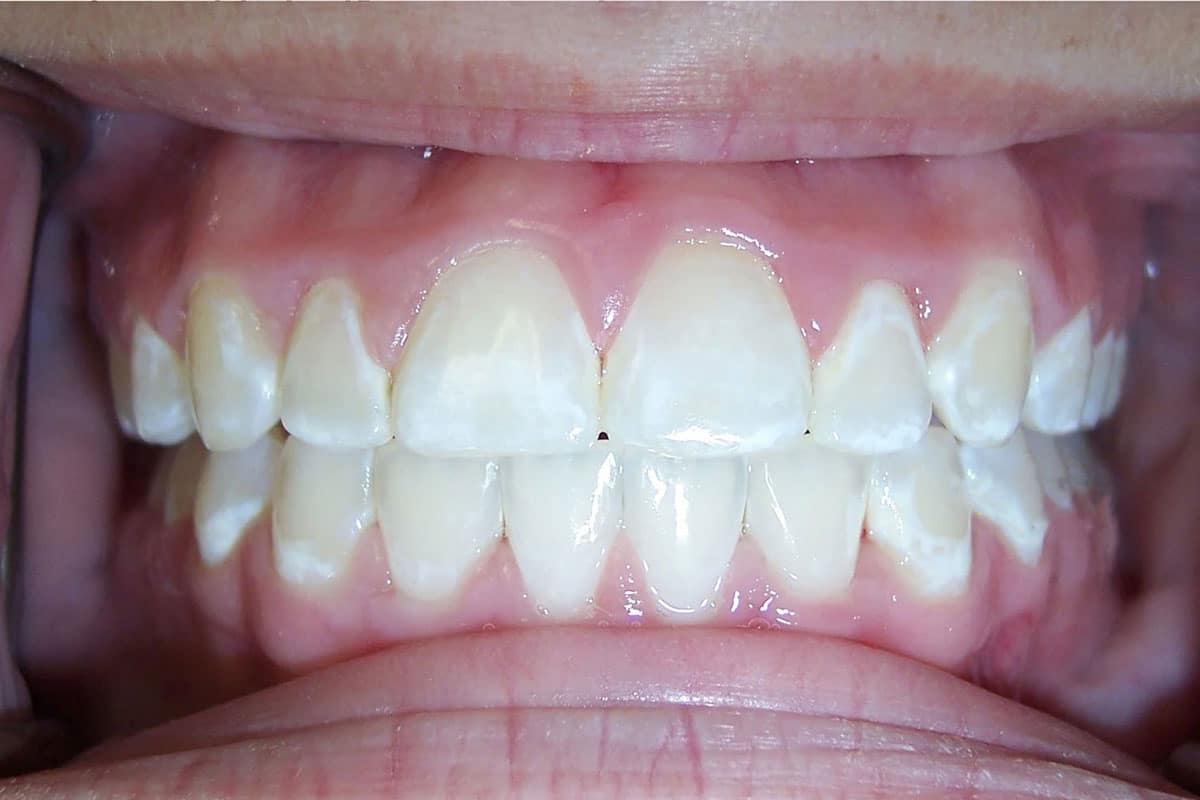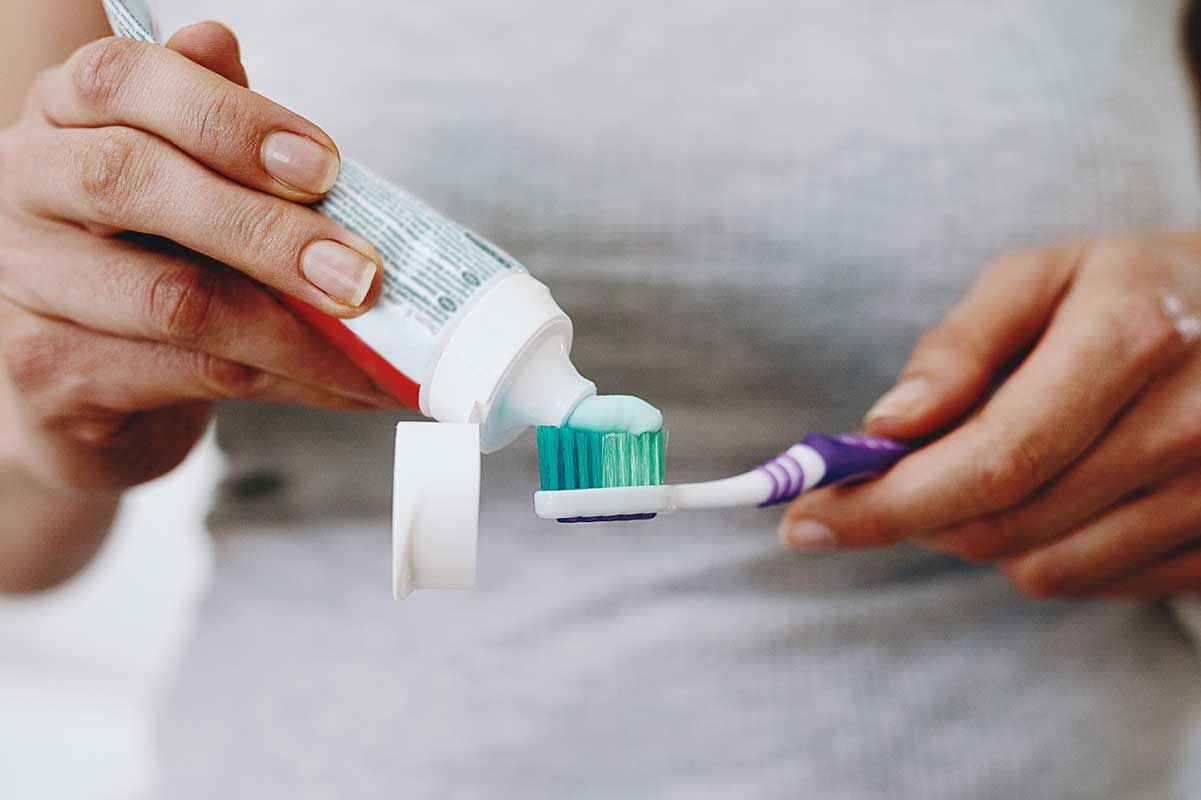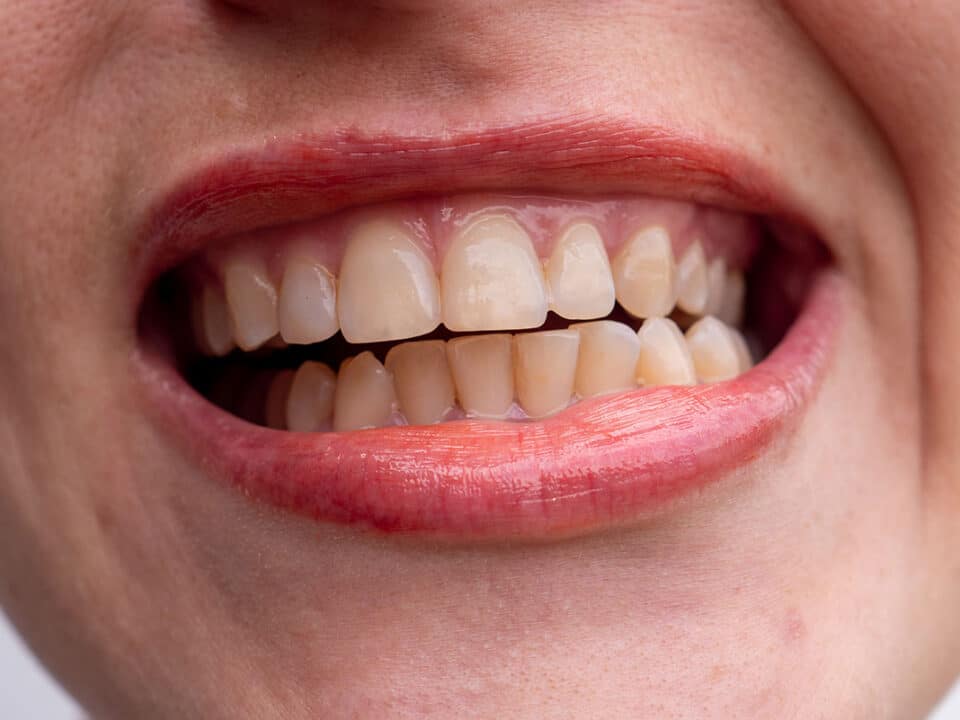Teeth whitening is one of the most common general cosmetic dentistry treatments we offer at our Martindale Dental clinics. It’s super popular amongst our patients, and for good reason; it works amazingly well to bring brightness back to a smile that’s lost its lustre. It’s also a fairly cost-effective, non-invasive treatment, and you’ll only have to spend a couple of hours in the dentist’s chair instead of requiring multiple appointments. Martindale dental teeth whitening is great for use as a touch-up tool and can be paired with take-home whitening trays to enhance the results further.
Our patients are almost unanimously thrilled with their teeth after whitening, but there is one main thing we get asked about after the treatment is complete. “Why do my teeth have white stains after whitening?”
Let us explain why.
Why do my teeth have white stains after whitening?!?
 To explain, we won’t go over the entire whitening procedure; instead, let’s begin with the last few steps or the clean-up if you will.
To explain, we won’t go over the entire whitening procedure; instead, let’s begin with the last few steps or the clean-up if you will.
Basically, once the whitening treatment is completed, your hygienist removes the UV light (the whitening gel is UV-activated), takes out the whitening mouthguard, and cleans off the gel. They will then show you your new smile in the mirror, at which point some of our patients notice that something doesn’t look quite right.
“What are those white lines I can see on my teeth?” they ask, with worried looks on their faces.
Undoubtedly, we agree, as it can be surprising and unsettling to see your teeth looking this way, especially when you were expecting an improved smile, not tooth enamel damage.
So what’s going on?
First of all, don’t worry! The white, patchy, streaky, or lined look of teeth after whitening is normal – it’s called enamel demineralization. Let us explain.
Understanding enamel demineralization after whitening
Enamel demineralization is a process where the minerals in the tooth enamel are lost, resulting in weakened and more susceptible teeth. This can occur after whitening treatments due to various factors.
The whitening gel used to whiten teeth professionally (in-office treatment) is powerful and contains hydrogen peroxide. This softens tooth enamel and dehydrates it, often causing demineralization in the process.
Dehydration is part of the process as the bleaching gel permeates through the enamel of your teeth to reach the dentin layer below, where the staining and discolouration have occurred over time. That’s where the gel needs to get to so it can do its work, but as a side effect, it can often cause bright white patches or streaks to show in your teeth and leave them looking less than perfect.
To reiterate, these white streaks after whitening are normal, will disappear as your teeth remineralize and won’t harm your teeth or oral health. So don’t worry – it’s only temporary dehydration causing the white marks.
*Side note
It’s important to understand that enamel demineralization is a natural process and doesn’t only happen during whitening. It can be caused or accelerated by natural factors, including poor oral hygiene, excessive consumption of acidic foods and beverages, habits like teeth grinding or clenching, or, in this case, by a teeth whitening procedure.
This is why some people may notice little white streaks in their teeth in the morning or if they haven’t been drinking enough. Of course, the level of streakiness is increased after whitening, but it will go away in a couple of days.
How to get rid of white spots on teeth after whitening: rehydrating tooth enamel

The enamel of your teeth is porous and will naturally soak up the hydration it needs on its own. However, you can help the process along in a couple of ways.
Drink lots of water
Ensure you stay hydrated by drinking plenty over the next few days, but stay away from coloured liquids and foods. Water is always best, but it’s especially important after whitening to stick to clear liquids only for a few days while the pores in your enamel reseal the barrier. Otherwise, stains can re-enter the dentin layer very easily and undo all the work the whitening treatment just did.
Use a remineralizing toothpaste or gel
One common treatment is tooth remineralization. This involves the application of remineralizing agents, such as fluoride varnishes or gels, to the affected teeth. These agents help replenish lost minerals and strengthen the enamel, reducing the appearance of white stains and restoring the health of the teeth.
We also recommend using a high-mineral toothpaste such as Sensodyne Repair so that your teeth have an ample supply of the minerals they need to rehydrate properly. This can really help speed up the process.
Most patients report that the white streaks in teeth after whitening are much less visible the next day after treatment and are gone two days later.
Preventative measures for enamel demineralization
You can take several preventive measures to protect your enamel from demineralization, especially after whitening treatments.
First and foremost, good oral hygiene is crucial. Brush your teeth at least twice daily with fluoride toothpaste and floss daily to remove plaque and bacteria contributing to enamel erosion. Additionally, consider using a mouthwash that contains fluoride to strengthen your enamel further.
Limit your consumption of acidic foods and beverages, as they can erode the enamel and contribute to demineralization. If you do consume acidic substances, rinse your mouth with water afterward to help neutralize the acids and minimize their effects on the teeth.
Wear a mouthguard if you grind or clench your teeth. This can help protect your enamel from excessive wear and tear.
Consider using enamel-strengthening toothpaste or remineralizing gels as recommended by your dentist. These products can help replenish lost minerals and strengthen the enamel, reducing the risk of demineralization.
Regular dental check-ups are also essential for maintaining enamel health. Your dentist can identify early signs of demineralization and provide appropriate treatments or recommendations to prevent further damage.
By following these preventive measures, you can maintain the health of your enamel and minimize the risk of post-whitening enamel demineralization.
What if the white streaks don’t go away?
In rare cases, the white patches or streaks can remain prominent and don’t go away. If this happens, then there could be another issue at play, like thinning tooth enamel, which would mean the streaks were already present in the tooth enamel before the treatment, and whitening has just made them more noticeable. This issue is something that your dentist or hygienist will have discussed with you before booking a whitening appointment. That’s why a consultation is required for all patients before a whitening appointment can be booked. We also check for gum recession, thinning enamel or other tooth decay issues that could cause side effects during or after whitening.
Another reason that white lines can appear in teeth is hypocalcification, a process that usually precedes cavity formation. This is the demineralization of teeth caused by a bad diet (lots of sugar) and bad dental hygiene. The acid produced by excess bacteria on teeth begins to weaken the enamel, causing white craze lines to develop in the process.
 Treatment options for white lines or spots that don’t go away
Treatment options for white lines or spots that don’t go away
White lines or spots that are not caused by dehydration do happen, and to get rid of them, you’ll need to visit a cosmetic dentist. A consultation appointment is necessary but typical treatment options include dental bonding and dental veneers. Both options work by covering up the front-facing side of your teeth so that any imperfections are hidden. These options will also strengthen weak teeth and reduce tooth sensitivity caused by thinning enamel.
Are you interested in teeth whitening?
If you’re interested in speaking with your dentist about teeth whitening, don’t hesitate to call our office or ask about it during your next checkup appointment. It’s important that you, as a patient, are informed about what the treatment entails and that your dentist can check your teeth to make sure teeth whitening is safe for you.
Check us out on Facebook and Twitter for daily information about Oral Health from Martindale Dental, or visit our offices in Hamilton and St. Catharines.
Have more questions?
Please contact us for all inquiries or to book an appointment with one of our convenient clinic locations. We look forward to hearing from you.


 Treatment options for white lines or spots that don’t go away
Treatment options for white lines or spots that don’t go away

